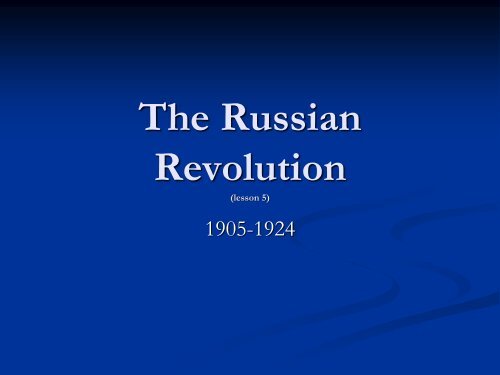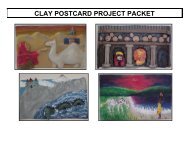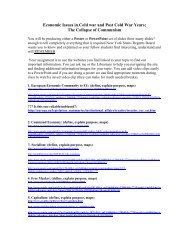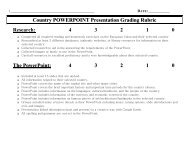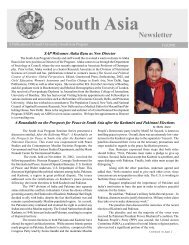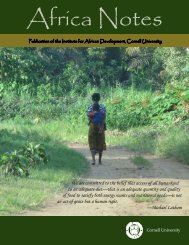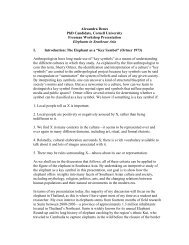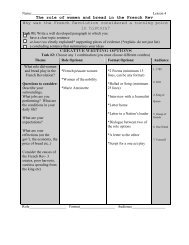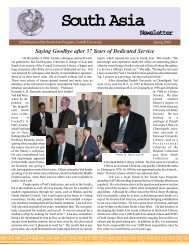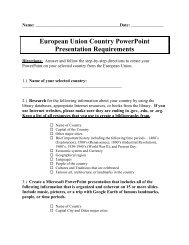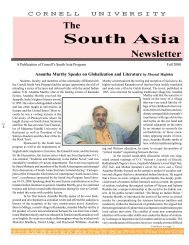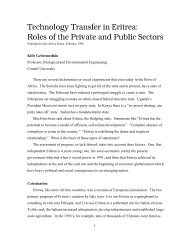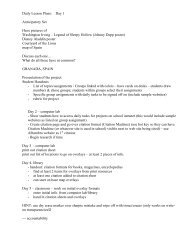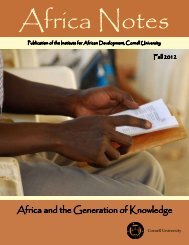Russian Revolution PowerPoint presentation (.pdf)
Russian Revolution PowerPoint presentation (.pdf)
Russian Revolution PowerPoint presentation (.pdf)
You also want an ePaper? Increase the reach of your titles
YUMPU automatically turns print PDFs into web optimized ePapers that Google loves.
The <strong>Russian</strong><br />
<strong>Revolution</strong><br />
(lesson 5)<br />
1905-1924
Table of Contents
Long Term Causes of <strong>Revolution</strong><br />
• Czarist Rule<br />
• Peasant Unrest<br />
• Problems of Urban Workers<br />
• Diversity and Nationalism
Pre-revolutionary Russia<br />
• Russia still ruled by Czars<br />
• Romanov dynasty still in<br />
power<br />
• Czar Nicholas II, the last<br />
<strong>Russian</strong> Czar, tried to<br />
industrialize and modernize<br />
Russia<br />
• Czar Nicholas resisted<br />
political reform and tried to<br />
suppress the ideals of selfrule<br />
and democracy (French<br />
Rev)<br />
• Used harsh tactics and secret<br />
police to keep power<br />
http://www.gwpda.org/memoir/FrAmbRus/images/pal1.jpg
Unhappiness<br />
Who is unhappy with the rule of Nicholas II<br />
- Working class: terrible living and working conditions<br />
and low wages, unions are outlawed. Socialists spread<br />
ideas about reform among these workers.<br />
- Minorities- ethnic and religious minorities<br />
discriminated against<br />
- Middle-class liberals- want self-rule<br />
- Peasants- rigid class system. no ownership of land<br />
and high taxes. Angry and fearful at industrialization<br />
because of fear of change
http://4.bp.blogspot.com/_-0f2OLadvVk/R5agafDOc4I/AAAAAAAAC4c/fFyX94moId8/s320/bloody-sunday.jpg<br />
<strong>Revolution</strong> of 1905<br />
• Defeat in war with<br />
Japan in 1904<br />
resulted in low spirits<br />
• This combined with<br />
peasant unhappiness<br />
leads to “Bloody<br />
Sunday”<br />
• In January 1905,<br />
peaceful protesters<br />
marched in St.<br />
Petersburg to<br />
influence Czar for<br />
reform<br />
• Czar Nicholas calls<br />
in soldiers and 1,000<br />
deaths result<br />
• Destroyed people’s<br />
faith/trust in czar
Change<br />
• After Bloody Sunday, violence breaks out<br />
throughout Russia<br />
• Czar Nicholas promises some reforms<br />
• Freedom of Speech<br />
- Establishment of Duma, elected national legislature<br />
Duma had limited powers and did little to relieve<br />
peasant and worker discontent. It was dissolved<br />
when it criticized the Czar
World War I<br />
• Russia member of Allied powers<br />
• Russia not ready for industrialized war<br />
• <strong>Russian</strong> soldiers not adequately prepared<br />
• <strong>Russian</strong> people lacked confidence in Russia’s<br />
military strength<br />
• Russia suffered many defeats at the hands of the<br />
Germans on the Eastern Front
The March <strong>Revolution</strong><br />
• Military defeats and food shortages culminated in a<br />
revolution in March 1917<br />
• Rioters in St. Petersburg demanded bread<br />
• Soldiers sympathized and refused to fire on them<br />
• With no control of his troops and facing anarchy in his<br />
country, Czar Nicholas abdicated (gave up) his throne<br />
in March 1917<br />
• Provisional (temporary) government set up, promised<br />
to write constitution<br />
• Unpopular decision to remain in WWI
In Slow Motion<br />
• Provision government slow to bring change<br />
• <strong>Revolution</strong>ary socialists set up soviets, councils<br />
of workers and soldiers, in <strong>Russian</strong> cities<br />
• Worked within the system that was set up<br />
• Taken over by a radical socialist party
The Rise of Lenin<br />
• Vladimir Lenin and Leon Trotsky headed a<br />
revolutionary socialist party, the Bolsheviks<br />
• Based on ideas of Karl Marx<br />
• An elite group of reformers, the Bolsheviks,<br />
would guide the revolution in Russia<br />
• Promises of “Peace, Land and Bread”<br />
• Promised an end to Russia in WWI<br />
• Promised land reform and an end to food<br />
shortages
Petrograd, 4 July 1917. Street demonstration on Nevsky Prospekt<br />
just after troops of the Provisional Government have opened fire with machine guns<br />
http://ibhistoryreview.wikispaces.com/file/view/38a2d72a.jpg/30560514/38a2d72a.jpg
• Nov. 1917, the<br />
Bolsheviks led<br />
soldiers, sailors and<br />
factory workers.<br />
Overthrew<br />
provisional<br />
government<br />
• Bolsheviks <br />
Communists<br />
• Distributed land to<br />
peasants and gave<br />
workers control of<br />
factories<br />
• http://ssl.schoolportal.co.uk/GroupDownloadAttachment.aspGroupId=671<br />
273&AttachmentID=591253<br />
QuickTime and a<br />
decompressor<br />
are needed to see this picture.
Lenin in Charge<br />
QuickTime and a<br />
decompressor<br />
are needed to see this picture.<br />
• Withdraws from WWI<br />
• Treaty of Brest Litovsk – costly, but knew that needed to<br />
make peace with Germany at any price so could deal with<br />
enemies at home<br />
• http://i.dailymail.co.uk/i/pix/2009/10/22/article-1222209-0021FC9000000258-784_468x266_popup.jpg
Civil War<br />
• 1918-1921 Lenin’s Red Army vs. the Whites (those<br />
loyal to czar)<br />
• Nationalist groups rebelled. Independence for Estonia,<br />
Latvia, Lithuania and Poland<br />
• Brutal tactics: Whites slaughtered communists.<br />
• Communists used secret police to root out enemies<br />
• Thousands executed by Communists who were<br />
SUSPECTED of opposing revolution<br />
• Executed Czar Nicholas and his entire family, the<br />
Romanovs
http://www.texemarrs.com/images/romanov_family_apr11.jpg
The Romanov Girls<br />
http://www.alef.net/ALEFPeople/AnastasiaRomanov/RomanovGirls.Gif
QuickTime and a<br />
decompressor<br />
are needed to see this picture.<br />
• GB, France and the US sent troops to help the Whites<br />
• Foreign intervention stirred <strong>Russian</strong> nationalism<br />
• Inspired the Red Army, and they defeated enemies by 1921.<br />
• http://images4.wikia.nocookie.net/__cb20100102221203/cybernations/images/a/a3/<strong>Russian</strong>_civil_war_1918-<br />
1920_white_army.jpg
One Party System<br />
• Lenin’s new government did not have a<br />
constitution and an elected legislature<br />
• Communist Party, not the people, had power<br />
• Only legal party<br />
• Only its members could run for office<br />
• Enforced will through military and secret police
The Economy<br />
• Bolshevik leaders during the civil war had taken<br />
over banks, mines, factories and RR’s.<br />
• Led to economic disaster!<br />
• New Economic Policy (NEP) adopted by Lenin,<br />
1921<br />
• Government owned banks, large industry, foreign<br />
trade<br />
• Allowed for private ownership of businesses<br />
• Allowed economy to recover, peasants flourished
1922 – Lenin and Communists<br />
had gained control over much<br />
of <strong>Russian</strong> empire<br />
Created the Union of Soviet<br />
Socialist Republics (USSR).<br />
(Soviet Union)<br />
Russia controlled the other<br />
states<br />
http://upload.wikimedia.org/wikipedia/commons/c/c3/Flag<br />
_of_the_Soviet_Union.png
QuickTime and a<br />
decompressor<br />
are needed to see this picture.<br />
http://novaonline.nvcc.edu/eli/evans/Photos/Russia/Maps/Map2000.jpg
Stalin and Communist Dictatorship<br />
• Lenin dies, 1924<br />
• Joseph Stalin, new<br />
Communist leader<br />
• He won the power struggle to<br />
lead the party edging out Leon<br />
Trotsky<br />
• Rules via terror and brutality<br />
• Great Purge – 1930s –<br />
accused thousands of crimes<br />
against the government.<br />
Fearful other Communists<br />
plotting against him<br />
• Executions and prison camps<br />
QuickTime and a<br />
decompressor<br />
are needed to see this picture.<br />
http://www.onthisdeity.com/wp-content/uploads/2011/03/Stalin1.jpg
Stalin’s Paranoia<br />
• “It’s necessary for those feared by the many to<br />
fear the many” –Publicius Syrus<br />
• Purge: to remove (usually with force or by<br />
killing) opponents or people considered<br />
undesirable from a state or organization<br />
• Many high officials in the communist party<br />
were killed, ie Kamenev and Zinoviev<br />
• Journey Into The Whirlwind by Eugenia Ginzburg
Key Terms<br />
• One party Rule: you are free to vote for anyone<br />
in the communist party, began with Lenin<br />
• Totalitarianism: Government that exercises<br />
absolute and centralized control over all aspects<br />
of life (i.e. dictators)<br />
• Russification: Stalin continued Czars hatred<br />
forced assassination of ethnic minorites. Now<br />
assimilation includes becoming a communist.<br />
<strong>Russian</strong>s hold most key positions<br />
• Stalin was not even <strong>Russian</strong>, He was from Georgia!
The Economy Under Stalin<br />
• Command Economy: Synonym for<br />
communism, the gov’t takes control/commands<br />
the economy<br />
• Five Year Plans: Stalin ends Lenin’s NEP and<br />
goes to command economic plan to set<br />
industrial, agricultural, and social goals<br />
• Heavy Industry, the creation of towns such as<br />
Magnitagorsk Behind the Urals by John Scott<br />
• Consumer goods decreased
Collectivization/Agriculture<br />
• Land is pooled into large farms and people work<br />
and live together<br />
• All receive the same amount of benefits<br />
• Often production quotas are forced<br />
• People running the farms often do not know the<br />
first thing about agriculture, Execution by Hunger<br />
by Miron Dolot<br />
• Kulak: “a rich peasant” a peasant who gained<br />
economic status from Lenin’s NEP era, and was<br />
targeted by Stalin


